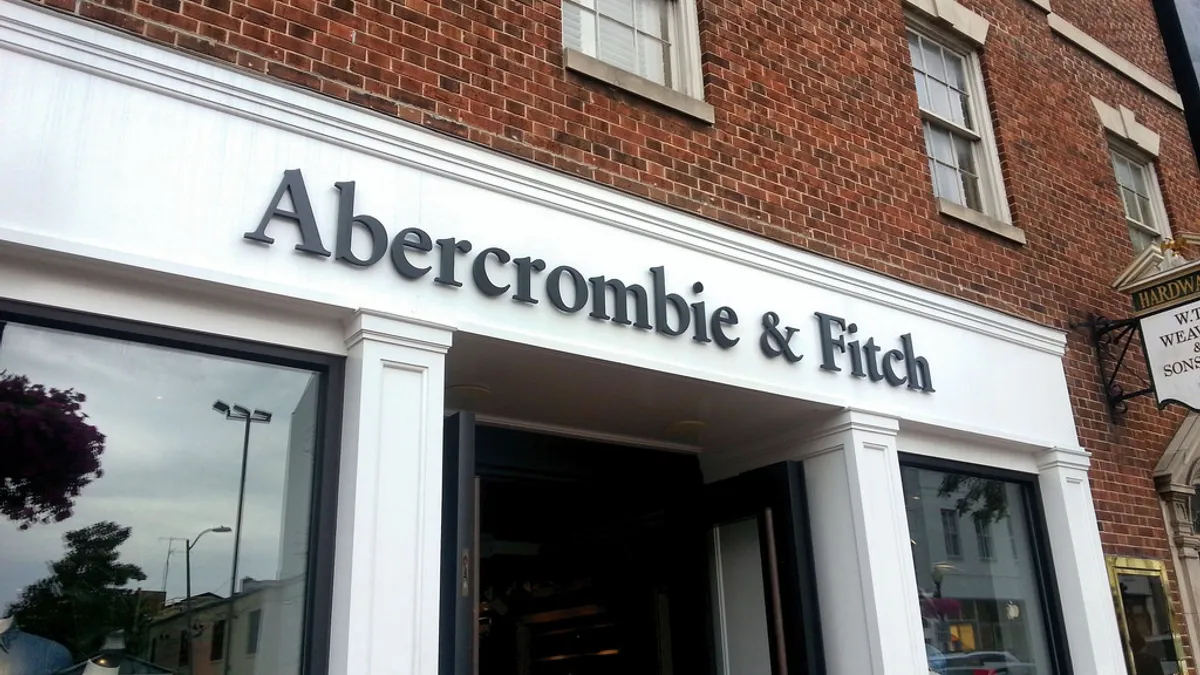Dive Brief:
-
Shares in Abercrombie & Fitch surged 25% Friday morning as the teen apparel company reported sales and profit results that handily bested analysts' expectations. Net revenue rose 5% percent to $859.11 million, beating the Thomson Reuters I/B/E/S estimate of $818.9 million cited by Reuters. By brand, the company’s lower-priced Hollister banner saw net sales for the third quarter rise 10% to $508.1 million. The flagship Abercrombie brand fell 2% to $351 million, the company said.
-
Net income for the company in the third quarter was $10.1 million, up from $7.9 million last year. Excluding certain items, adjusted non-GAAP net income in the quarter was $20.5 million, compared to $1.4 million last year or 30 cents per share, beating estimates cited by Reuters for 22 cents per share.
-
Same-store sales for the third quarter rose 4%, according to a company press release, beating analysts' average estimate cited by Reuters for a 0.3% increase. Hollister alone saw same-store sales rise 8% as the flagship's same-store sales fell 2%. Direct-to-consumer sales grew to approximately 24% of total company net sales for the third quarter, compared to about 23% in the year-ago quarter.
Dive Insight:
Abercrombie & Fitch has finally taken some bold steps to reverse its fortunes. The retailer long promised to brighten stores and ditch its sexualized marketing, and has finally got around to that. Some of the changes in merchandising implemented last spring failed to resonate, however, and failed to translate into a stronger brand identity, according to GlobalData Retail analyst Håkon Helgesen told Retail Dive in August.
GlobalData analysts were expecting better for fall, and Abercrombie has delivered. In fact the company has "ripped up the rulebook and completely reinvented itself," GlobalData Retail managing director Neil Saunders told Retail Dive in an email.
"There have been significant improvements in quality, especially to fabric and stitching. Subtle detailing, like more stylish buttons on shirts, has also helped to give basic garments a lift," he said. "On top of this, the big logos of the past have been firmly ditched in favor of no-branding or very subtle A+F monograms. The net effect is a range that is more mature and sophisticated, with much more emphasis on fit and function than branding."
The reality, though, is that Hollister — like Gap Inc.’s lower-priced, more casual Old Navy brand — is the more robust banner, which CEO Fran Horowitz acknowledged in her statement on Friday.
"Hollister delivered another quarter of sales growth across all channels and geographies, and Abercrombie is beginning to show signs of stabilization," she said. "We are pleased by the clear progress across all brands, delivering another quarter of sequential comparable sales improvement, and a return to positive comparable sales. This sales performance in combination with disciplined expense management drove profit growth, despite the promotional environment."
Horowitz was alluding to the company’s first positive same store sale increase since its fourth quarter of 2015, "and its biggest quarterly comp in 24 quarters — dating all the way back to a 9% gain in [the second quarter of 2011]," according to a note emailed to Retail Dive from Retail Metrics President Ken Perkins.
The flagship Abercrombie brand's turnaround is at an earlier stage, Saunders told Retail Dive on Friday. "As good as the headline figure is, it masks disparities between A&F's two core brands," he said in an email. "That Hollister is performing better than Abercrombie is not surprising. Hollister's brand reinvention program is more advanced, and initiatives like the Club Cali loyalty program have had much longer to play out. As a result, the brand is engaging far more with its customer base and enticing them with relevant on-trend product across categories like denim and intimates. Abercrombie has not been neglected, but the division's reinvention is at an earlier stage and so financial results are nowhere near as positive. Having seen the work undertaken at Abercrombie, we are confident that progress is being made and that the direction of travel is correct."
Abercrombie continues to test a new store concept, which has furnished the departure from the darkly-lit, heavily perfumed stores — an approach held over from the tenure of CEO Mike Jeffries, who created an exclusive ethos catering to some mythic cool kid. The new prototype hews more closely to Abercrombie's roots as an all-American brand that "reflects that confidence and independence of spirit as well as our own dedication to a more diverse and inclusive culture," the company said last year, with an emphasis on more diverse and clothed models, more denim and less logo-centric clothing. The rebrand seeks to take advantage of Abercrombie’s 125-year history as a preppy American retailer, Horowitz has said.
Saunders called the new format "impressive," noting, however, that with only a handful of them open, the impact on Abercrombie's sales is small. "It is revolutionary rather than evolutionary, and is a significant step forward for the brand," he said. "The two most immediately striking things about the new design are how light and open it is, and how subtle the branding is. Alone, these make the shops almost unrecognizable as A&Fs."
The brand does have more work to do, he warned: "While initiatives like the loyalty scheme are working well, Abercrombie needs to communicate its new essence more effectively and more widely."













